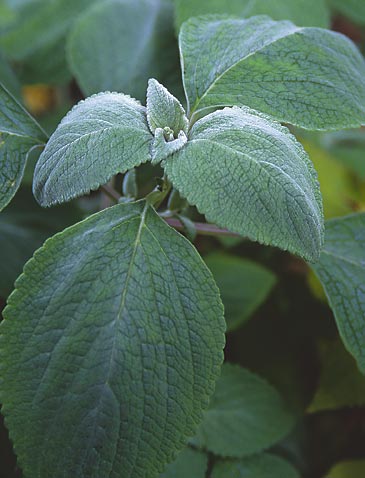 Jonathon Hofley / Michigan Gardener
Jonathon Hofley / Michigan Gardener
Plectranthus argentatusby George Papadelis
Gardeners continue to covet beautiful foliage in every aspect of their landscapes. More than ever, we are likely to look beyond the flowers and learn to appreciate the foliage; flowers come and go, but foliage endures. In perennial gardens, for example, fancy-leaved versions of old favorites are very popular. Trendy perennials like the Jacob’s ladder (Polemonium) ‘Stairway to Heaven,’ phlox ‘Becky Towe,’ and bugbane (Cimicifuga or Actaea) ‘Hillside Black Beauty’ are adorned with much more decorative foliage than their green-leaved relatives. Some popular annuals like coleus and sweet potato vine are used purely for their gorgeous leaves. Plectranthus is also grown primarily for its gorgeous leaves, like its relative coleus. This enormous genus is also blessed with fragrant leaves and a huge range of uses.
Most of the ornamental plectranthus have the unique ability to tolerate either sun or shade. The durable leaves rarely shed and will withstand strong winds. Plectranthus is also very drought tolerant and even quite tolerant of rough handling.
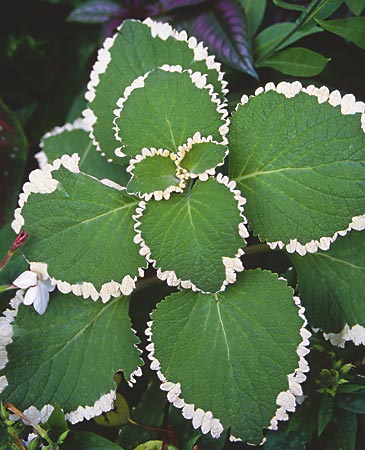 Jonathon Hofley / Michigan Gardener
Jonathon Hofley / Michigan Gardener
Plectranthus fosteri ‘Marginatus’The genus is most easily divided into three distinct groups: 1) upright foliage, 2) trailing foliage, and 3) attractive flowers. Among the upright forms, we have the silver-leaved Plectranthus argentatus. Silver foliage is almost always desirable amongst other foliage and flowers. These prefer sun and produce large silver leaves with a felt-like texture and slightly serrated edges. They may grow up to two or three feet tall, making them ideal for larger plantings or containers. Pinching may be necessary to control height and encourage branching. I have seen Plectranthus argentatus used in the center of a large container in combination with the upright blue angelonia, pink trailing petunias, and white trailing Nierembergia—a beautiful and durable combination.
It should be noted that almost every plectranthus is grown from cuttings. That means you will typically pay a bit more for a single plant (compared to seed-produced plants). In 2005, however, there was a breakthrough in plectranthus. Some seed companies began offering a new Plectranthus argentatus grown from seed called ‘Silver Shield.’ It branches better than the one grown from cuttings and the height and spread are about 24 inches. Seed-grown plants are typically a bit more affordable since they are often available in flats.
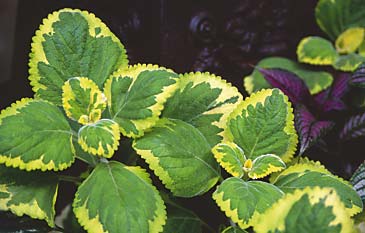 Jonathon Hofley / Michigan Gardener
Jonathon Hofley / Michigan Gardener
Plectranthus fosteri ‘Green on Green’The other upright forms are Plectranthus fosteri ‘Marginatus’ and Plectranthus fosteri ‘Green on Green.’ The former has green and white variegated foliage and the latter has green and gold variegated foliage. The leaves are similar to Plectranthus argentatus, but are sometimes much larger. The thick, scented leaves on upright stems weave beautifully amongst the flowers and leaves of other annuals or perennials. Both of these can be very quickly grown into standards: stake the stalk to the desired height, then repeatedly pinch to create a terminal poodle or globe shape. These prefer sun or part sun.
The trailing varieties will thrive in sun or shade. They can be used for bedding or simply used as a more interesting vinca vine replacement. For trailing silver leaves, try Plectranthus x ‘Silver Foil.’ Plectranthus madagascariensis ‘Variegatus’ has bright green and white variegated leaves that will trail down and continue to maintain a nice mounded habit. It is striking next to bright colors like petunias or with the white flowers of Bacopa.
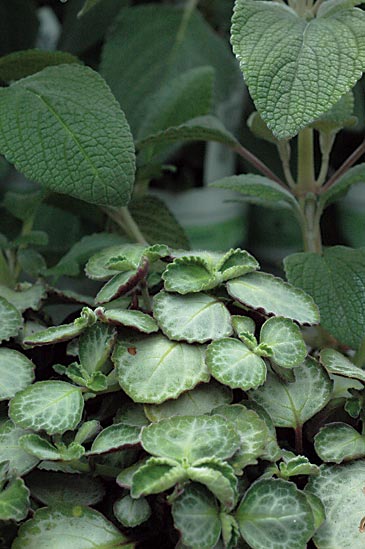 Jonathon Hofley / Michigan Gardener
Jonathon Hofley / Michigan Gardener
Plectranthus oertendahlii ‘Uvongo’One of the most interesting trailing forms is Plectranthus oertendahlii ‘Uvongo.’ It hugs the ground and produces beautiful silver and green patterned leaves. The best part is the showy purple-pink undersides that reveal themselves just enough to give ‘Uvongo’ delicate rose accents. In more sun, the stems turn purple and so does the new growth. Try this one in a container interplanted with euphorbia ‘Diamond Frost’ (tiny upright flowers) and the blue trailing flowers of lobelia ‘Big Blue.’
Another beautiful trailing plectranthus is ‘Troy’s Gold.’ This one is also quite short, only growing to about five inches tall. Leaves are brightly variegated green and gold with some deep purple veins. The stems and leaf undersides on ‘Troy’s Gold’ are also purple. Plant this one with any purple or gold flowers for optimum impact.
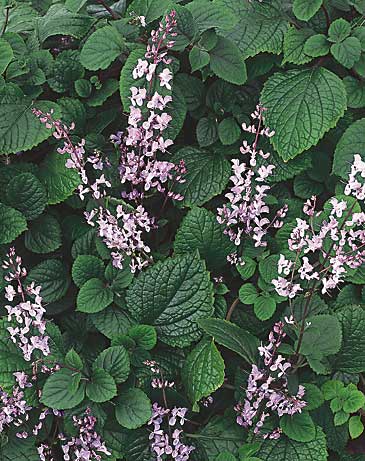 provenwinners.com
provenwinners.com
Plectranthus ‘Zulu Wonder’The common Swedish ivy (Plectranthus australis) is another trailing plectranthus. Its glossy, dark green leaves can cascade as far down as 3 to 4 feet. Plants persist effortlessly in hanging baskets and can thrive in either sun or shade. Interiorscapers test this plant’s durability again and again in thousands of restaurants, offices, and mall plantings.
Among the flowering varieties, there are a few that are somewhat available. ‘Zulu Wonder’ has lavender-blue flowers, while ‘Lois Woodhull’ bears beautiful flower spikes of bluish-rose and white from summer until fall. It only grows about 10 to 12 inches tall and has thick, green leaves. For a unique, late-blooming annual, look for ‘Mona Lavender.’ Its stunning late summer display consists of large, lavender-flecked blossoms on contrasting dark stems. The leaves are a glossy dark green on top and burgundy underneath. It can exceed 18 inches in height when provided with ample space.
Consider trying the beautiful foliage or flowers of a plectranthus—they offer a delightful alternative to mainstream annual bedding plants.
George Papadelis is the owner of Telly’s Greenhouse in Troy, MI.
At a glance: Plectranthus
Common name: Swedish ivy
Plant type: Annual (tender perennial)
Habit: Upright and trailing varieties
Plant size: Upright varieties: up to 3 feet tall and wide; Trailing varieties: up to 12 inches tall
Leaf color: Silver, gray-green, green and white variegated, green and gold variegated, green
Leaf size: Rounded, 1 to 4 inches long and wide, depending on variety
Light: Sun to shade
Soil: Well-drained
Uses: Upright varieties: large containers, annual and perennial borders; Trailing varieties: front of containers, hanging baskets, wall plantings
Companion plants: The many foliage colors compliment a wide array of annuals and perennials.
Remarks: Grown for its foliage, like coleus. Foliage weaves nicely amongst other plants. Upright forms can be easily trained into standards. Size of upright varieties can be controlled with pinching. Silver-leaved varieties prefer more sun.
